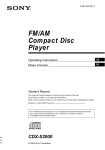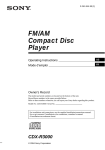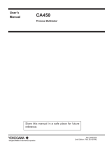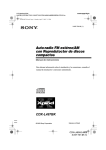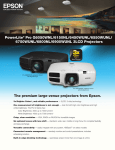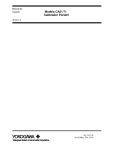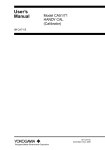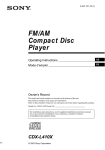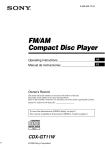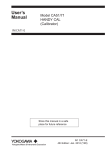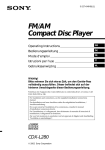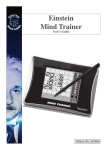Download Sony CDX-SW200 User's Manual
Transcript
3-261-840-51 (1) FM/AM Compact Disc Player Operating Instructions US Manual de instrucciones ES Owner’s Record The model and serial numbers are located on the bottom of the unit. Record these numbers in the space provided below. Refer to these numbers whenever you call upon your Sony dealer regarding this product. Model No. CDX-SW200 Serial No. For installation and connections, see the supplied installation/connections manual. Para obtener información sobre la instalación y las conexiones, consulte el manual de instalación/conexiones suministrado. CDX-SW200 © 2004 Sony Corporation Warning Welcome ! This equipment has been tested and found to comply with the limits for a Class B digital device, pursuant to Part 15 of the FCC Rules. These limits are designed to provide reasonable protection against harmful interference in a residential installation. This equipment generates, uses, and can radiate radio frequency energy and, if not installed and used in accordance with the instructions, may cause harmful interference to radio communications. However, there is no guarantee that interference will not occur in a particular installation. If this equipment does cause harmful interference to radio or television reception, which can be determined by turning the equipment off and on, the user is encouraged to try to correct the interference by one or more of the following measures: – Reorient or relocate the receiving antenna. – Increase the separation between the equipment and receiver. – Connect the equipment into an outlet on a circuit different from that to which the receiver is connected. – Consult the dealer or an experienced radio/TV technician for help. Thank you for purchasing this Sony Compact Disc Player. You can enjoy its various features even more with: Optional controller accessory Card remote commander RM-X114 You are cautioned that any changes or modifications not expressly approved in this manual could void your authority to operate this equipment. CAUTION The use of optical instruments with this product will increase eye hazard. 2 Table of Contents Location of controls . . . . . . . . . . . . . . . . . . . 4 Precautions . . . . . . . . . . . . . . . . . . . . . . . . . . 5 Notes on discs . . . . . . . . . . . . . . . . . . . . . . . . 6 Getting Started Resetting the unit . . . . . . . . . . . . . . . . . . . . . . 7 Detaching the front panel . . . . . . . . . . . . . . . 7 Setting the clock . . . . . . . . . . . . . . . . . . . . . . 8 CD Player Playing a disc. . . . . . . . . . . . . . . . . . . . . . . . . 9 Display items . . . . . . . . . . . . . . . . . . . . . . . . . 9 Playing tracks repeatedly — Repeat Play . . . . . . . . . . . . . . . . . . . . 10 Playing tracks in random order — Shuffle Play . . . . . . . . . . . . . . . . . . . . 10 Other Functions Adjusting the balance and fader . . . . . . . . . Quickly attenuating the sound . . . . . . . . . . Changing the sound and display settings . . . . . . . . . . . . . . . . . . . . . . . . . . Setting the equalizer (EQ3). . . . . . . . . . . . . 12 12 12 13 Additional Information Maintenance . . . . . . . . . . . . . . . . . . . . . . . . Removing the unit. . . . . . . . . . . . . . . . . . . . Specifications . . . . . . . . . . . . . . . . . . . . . . . Troubleshooting . . . . . . . . . . . . . . . . . . . . . Error displays/Message. . . . . . . . . . . . . . . . 14 15 16 17 18 Radio Storing stations automatically — Best Tuning Memory (BTM). . . . . . . 10 Receiving the stored stations . . . . . . . . . . . . 11 Storing only the desired stations . . . . . . . . . 11 3 Location of controls Refer to the pages listed for details. SEL SEEK MODE OFF SOURCE ATT SENS 1 2 REP SHUF 3 4 EQ3 5 6 BTM DSPL CDX-SW200 a Volume +/– button b SEL (select) button Selecting items. c MODE button Changing the operation. d Display window e OFF (Stop/Power off) button* 7, 9 f Z (eject) button 9 g (front panel release) button 7 h SOURCE (Power on/Radio/CD) button Selecting the source. i ATT (attenuate) button 12 j SENS button 11 k RESET button (located on the front side of the unit, behind the front panel) 7 l Number buttons 12 Radio: Storing the desired station on each number button. CD: (3): REP 10 (4): SHUF 10 4 m BTM (Best Tuning Memory) button 10 n DSPL (display mode change) button 8, 9 o EQ3 button 13 p Receptor for the card remote commander q SEEK +/– button Radio: Tuning in stations automatically/finding a station manually. CD: Skipping tracks/fast-forwarding, reversing a track. * Warning when installing in a car without an ACC (accessory) position on the ignition switch After turning off the ignition, be sure to press and hold (OFF) on the unit until the display disappears. Otherwise, the display does not turn off and this causes battery drain. Card remote commander RM-X114 (optional) DSPL MODE PRESET + MENU SEEK– SOUN D DISC + SOURCE DISC – LIST + • If your car has been parked in direct sunlight, allow the unit to cool off before operating it. • Power antenna will extend automatically while the unit is operating. If you have any questions or problems concerning your unit that are not covered in this manual, please consult your nearest Sony dealer. Moisture condensation SEEK+ R ENTE PRESET – OFF Precautions ATT On a rainy day or in a very damp area, moisture condensation may occur inside the lenses and display of the unit. Should this occur, the unit will not operate properly. In such a case, remove the disc and wait for about an hour until the moisture has evaporated. VOL – To maintain high sound quality Be careful not to splash juice or other soft drinks onto the unit or discs. The corresponding buttons of the card remote commander control the same functions as those on this unit. a b c d e f g h i j k l DSPL button MENU button* SOURCE button SEEK (–/+) buttons SOUND button OFF button VOL (+/–) buttons MODE button LIST button* DISC*/PRESET (+/–) button ENTER button* ATT button * Not available for this unit Note If the display disappears by pressing (OFF), it cannot be operated with the card remote commander unless (SOURCE) on the unit is pressed, or a disc is inserted to activate the unit first. Tip Refer to “Replacing the lithium battery” for details on how to replace the battery (page 14). 5 Notes on discs • To keep a disc clean, do not touch its surface. Handle the disc by its edge. • Keep your discs in their cases or disc magazines when not in use. • Do not subject discs to heat/high temperature. Avoid leaving them in a parked car or on a dashboard/rear tray. • Before playing, clean the discs with a commercially available cleaning cloth. Wipe each disc from the center out. Do not use solvents such as benzine, thinner, commercially available cleaners, or antistatic spray intended for analog discs. Notes on CD-R/CD-RW discs • Do not attach labels, or use discs with sticky ink/residue. Such discs may stop spinning when used, causing a malfunction, or may ruin the disc. • You can play CD-Rs (recordable CDs)/CDRWs (rewritable CDs) designed for audio use on this unit. Look for these marks to distinguish CD-Rs/ CD-RWs for audio use. These marks denote that a disc is not for audio use. • Do not use any discs with labels or stickers attached. The following malfunctions may result from using such discs: – Inability to eject a disc (due to a label or sticker peeling off and jamming the eject mechanism). – Inability to read audio data correctly (e.g., playback skipping, or no playback) due to heat shrinking of a sticker or label causing a disc to warp. • Discs with non-standard shapes (e.g., heart, square, star) cannot be played on this unit. Attempting to do so may damage the unit. Do not use such discs. • You cannot play 8 cm (3 in) CDs. 6 • Some CD-Rs/CD-RWs (depending on the equipment used for its recording or the condition of the disc) may not play on this unit. • You cannot play a CD-R/a CD-RW that is not finalized*. * A process necessary for a recorded CD-R/CD-RW disc to be played on the audio CD player. Getting Started Detaching the front panel You can detach the front panel of this unit to protect the unit from being stolen. Resetting the unit Before operating the unit for the first time, or after replacing the car battery or changing the connections, you must reset the unit. Remove the front panel and press the RESET button with a pointed object, such as a ball-point pen. Caution alarm If you turn the ignition switch to the OFF position without removing the front panel, the caution alarm will beep for a few seconds. If you connect an optional amplifier and do not use the built-in amplifier, the beep sound will be deactivated. 1 * If your car has no ACC (accessory) position on the ignition switch, be sure to turn the unit off by pressing (OFF) until the display disappears to avoid car battery drain. RESET button Note Pressing the RESET button will erase the clock setting and some stored contents. Press (OFF)*. CD playback or radio reception stops (the key illumination and display remain on). 2 Press , then pull it off towards you. (OFF) Notes • If you detach the panel while the unit is still turned on, the power will turn off automatically to prevent the speakers from being damaged. • Do not drop or put excessive pressure on the front panel and its display window. • Do not subject the front panel to heat/high temperature or moisture. Avoid leaving it in a parked car or on a dashboard/rear tray. Tip When carrying the front panel with you, use the supplied front panel case. continue to next page t 7 Attaching the front panel Attach part A of the front panel to part B of the unit as illustrated and push the left side into position until it clicks. Setting the clock The clock uses a 12-hour digital indication. Example: To set the clock to 10:08 1 Press (DSPL) for 2 seconds. The hour indication flashes. 1 Press the volume +/– button to set the hour. A B 2 Press (SEL). The minute indication flashes. 3 Press the volume +/– button to set the minute. Note Do not put anything on the inner surface of the front panel. 2 Press (DSPL). The clock starts. After the clock setting is completed, the display returns to normal play mode. 8 Display items CD Player The following items can be displayed. Source Playing a disc Insert the disc (labeled side up). Track number Displayable items • Elapsed playing time • Clock Playback starts automatically. To If a disc is already inserted, press (SOURCE) repeatedly until “CD” appears to start playback. To Press Stop playback Z or (OFF) Eject the disc Z Skip tracks – Automatic Music Sensor (SEEK) (–/+) (./>) [once for each track] Fast-forward/ reverse – Manual Search (SEEK) (–/+) (m/M) [hold to desired point] Press Switch display item (DSPL) Notes • While the first/last track on the disc is playing, if (SEEK) (–) or (SEEK) (+) is pressed, playback skips to the last/first track of the disc. • When the last track on the disc is over, playback restarts from the first track of the disc. 9 Playing tracks repeatedly — Repeat Play The current track will repeat itself when it reaches the end. During playback, press (3) (REP) until “REP” indicator appears in the display. Radio The unit can store up to 6 stations per band (FM1, FM2, FM3, AM1, and AM2). Caution When tuning in stations while driving, use Best Tuning Memory to prevent accidents. “REP” indicator is displayed. Storing stations automatically Repeat Play starts. To return to normal play mode, press (3) (REP) again. Playing tracks in random order — Shuffle Play You can select to play the tracks in the current disc in random order. During playback, press (4) (SHUF) until “SHUF” indicator appears in the display. “SHUF” indicator is displayed. Shuffle Play starts. To return to normal play mode, press (4) (SHUF) again. 10 — Best Tuning Memory (BTM) The unit selects the stations with the strongest signals within the selected band, and stores them in the order of their frequency. 1 Press (SOURCE) repeatedly to select the radio. 2 Press (MODE) repeatedly to select the band. 3 Press (BTM) for 2 seconds. The unit stores stations in the order of their frequencies on the number buttons. A beep sounds when the setting is stored. Notes • If only a few stations can be received due to weak signals, some number buttons will retain their former settings. • When a number is indicated in the display, the unit starts storing stations from the one currently displayed. Receiving the stored stations 1 Press (SOURCE) repeatedly to select the radio. 2 Press (MODE) repeatedly to select the band. 3 Press the number button ((1) to (6)) on which the desired station is stored. If FM stereo reception is poor — Monaural Mode During radio reception, press (SENS) repeatedly until “MONO” indicator appears in the display. “MONO” indicator is displayed. The sound improves, but becomes monaural (“ST” disappears). If preset tuning does not work — Automatic tuning/Local Seek Mode Automatic tuning: Press (SEEK) (+) or (SEEK) (–) to search for the station. Scanning stops when the unit receives a station. Repeat the operation until the desired station is received. To return to normal radio reception mode, press (SENS) again (“MONO” indicator turns off). Storing only the desired stations Local Seek Mode: If the automatic tuning stops too frequently, press (SENS) repeatedly until “LCL” indicator appears in the display. You can manually preset the desired stations on any chosen number button. 1 Press (SOURCE) repeatedly to select the radio. “LCL” indicator is displayed. 2 Press (MODE) repeatedly to select the band. 3 Press (SEEK) (+) or (SEEK) (–) to tune in the station that you want to store. 4 Press the desired number button ((1) to (6)) for 2 seconds until “MEM” appears. The number button indication appears in the display. Only the stations with relatively strong signals will be tuned in. To cancel the local seek mode, press (SENS) twice when receiving FM. Note When receiving AM, to cancel the local seek mode, press (SENS) (“LCL” indicator turns off). Tip If you know the frequency of the station you want to listen to, press and hold (SEEK) (+) or (SEEK) (–) to locate the approximate frequency, then press (SEEK) (+) or (SEEK) (–) repeatedly to fine adjust to the desired frequency (manual tuning). Note If you try to store another station on the same number button, the previously stored station will be erased. 11 Other Functions Adjusting the balance and fader You can adjust the balance and fader. 1 Press (SEL) repeatedly until “BAL” or “FAD” appears. Each time you press (SEL), the item changes as follows: LOW* t MID* t HI* t BAL (left-right) t FAD (front-rear) 2 The following items can be set: • DEMO* — to turn the demonstration display on or off. – Select “ON” to activate the demonstration display (The demonstration starts about 10 seconds after the unit is turned off). – Select “OFF” to deactivate the demonstration display. • BEEP — to turn the beeps on or off. Selecting the desired item Press (SEL) and the desired preset number button simultaneously. * When EQ3 is activated (page 13). (SEL) + (4): DEMO* Press the volume +/– button to adjust the selected item. (SEL) + (6): BEEP Note Adjust within 3 seconds after selecting the item. Quickly attenuating the sound Press (ATT). “ATT” appears in the display. To restore the previous volume level, press (ATT) again. 12 Changing the sound and display settings * When the unit is turned off. To cancel the item, press (SEL) and the preset number button simultaneously again. Setting the equalizer (EQ3) You can select an equalizer curve for 7 music types (XPLOD, VOCAL, CLUB, JAZZ, NAGE, ROCK, CUST, and OFF (equalizer OFF)). You can store a different equalizer setting for each source. Selecting the equalizer curve 1 Press (SOURCE) to select a source (Radio or CD). 2 Press (EQ3) repeatedly until the desired equalizer curve. Each time you press (EQ3), the item changes. Adjusting the equalizer curve You can store and adjust the equalizer settings for different tone ranges. 1 Press (SOURCE) to select a source (Radio or CD). 2 Press (EQ3) repeatedly to select the desired equalizer curve. 3 Adjusting the equalizer curve. 1 Press (SEL) repeatedly to select the desired tone range. Each time you press (SEL), the tone range changes. LOW t MID t HI (t BAL t FAD) 2 Press the volume +/– button repeatedly to adjust to the desired volume level. The volume level is adjustable by 1 dB steps from –10 dB to +10 dB. To cancel the equalizing effect, select “OFF.” 3 Repeat step 1 and 2 to adjust the equalizer curve. To restore the factory-set equalizer curve, press (SEL) for 2 seconds. After 3 seconds, the display returns to normal play mode. Note When EQ3 is set to “OFF,” you cannot adjust the equalizer curve settings. 13 Replacing the lithium battery Additional Information Maintenance Fuse replacement Under normal conditions, battery will last approximately 1 year. (The service life may be shorter, depending on the conditions of use.) When the battery becomes weak, the range of the card remote commander becomes shorter. Replace the battery with a new CR2025 lithium battery. Use of any other battery may present a risk of fire or explosion. When replacing the fuse, be sure to use one matching the amperage rating stated on the original fuse. If the fuse blows, check the power connection and replace the fuse. If the fuse blows again after replacement, there may be an internal malfunction. In such a case, consult your nearest Sony dealer. x + side up Fuse (10 A) Warning Never use a fuse with an amperage rating exceeding the one supplied with the unit as this could damage the unit. Cleaning the connectors The unit may not function properly if the connectors between the unit and the front panel are not clean. In order to prevent this, detach the front panel (page 7) and clean the connectors with a cotton swab dipped in alcohol. Do not apply too much force. Otherwise, the connectors may be damaged. Notes on lithium battery • Keep the lithium battery out of the reach of children. Should the battery be swallowed, immediately consult a doctor. • Wipe the battery with a dry cloth to assure a good contact. • Be sure to observe the correct polarity when installing the battery. • Do not hold the battery with metallic tweezers, otherwise a short-circuit may occur. WARNING Main unit Back of the front panel 14 Notes • For safety, turn off the ignition before cleaning the connectors, and remove the key from the ignition switch. • Never touch the connectors directly with your fingers or with any metal device. Battery may explode if mistreated. Do not recharge, disassemble, or dispose of in fire. Removing the unit 1 2 Remove the unit. 1 Insert both release keys together until they click. Remove the protection collar. 1 Detach the front panel (page 7). 2 Engage the release keys together with the protection collar. Orient the release key correctly. Face the hook inwards. 2 Pull the release keys to unseat the unit. 3 Pull out the release keys to remove the protection collar. 3 Slide the unit out of the mounting. 15 Specifications AUDIO POWER SPECIFICATIONS POWER OUTPUT AND TOTAL HARMONIC DISTORTION 23.2 watts per channel minimum continuous average power into 4 ohms, 4 channels driven from 20 Hz to 20 kHz with no more than 5% total harmonic distortion. General CD Player section Signal-to-noise ratio Frequency response Wow and flutter 120 dB 10 – 20,000 Hz Below measurable limit Outputs Tuner section FM Tuning range Antenna terminal Intermediate frequency Usable sensitivity Selectivity Signal-to-noise ratio 87.5 – 107.9 MHz External antenna connector 10.7 MHz/450 kHz 9 dBf 75 dB at 400 kHz 67 dB (stereo), 69 dB (mono) Harmonic distortion at 1 kHz 0.5 % (stereo), 0.3 % (mono) Separation 35 dB at 1 kHz Frequency response 30 – 15,000 Hz 530 – 1,710 kHz External antenna connector 10.7 MHz/450 kHz 30 µV Power amplifier section Outputs Speaker impedance Maximum power output 16 Power requirements Dimensions Mounting dimensions Mass AM Tuning range Antenna terminal Intermediate frequency Sensitivity Inputs Tone controls Speaker outputs (sure seal connectors) 4 – 8 ohms 52 W × 4 (at 4 ohms) Supplied accessories Optional accessory Audio outputs terminal (rear) Power antenna relay control terminal Power amplifier control terminal Antenna input terminal Low: ±10 dB at 60 Hz (XPLOD) Mid: ±10 dB at 1 kHz (XPLOD) High: ±10 dB at 10 kHz (XPLOD) 12 V DC car battery (negative ground) Approx. 178 × 50 × 176 mm (7 1/8 × 2 × 7 in) (w/h/d) Approx. 182 × 53 × 161 mm (7 1/4 × 2 1/8 × 6 3/8 in) (w/h/d) Approx. 1.2 kg (2 lb 10 oz) Parts for installation and connections (1 set) Front panel case (1) Card remote commander RM-X114 Design and specifications are subject to change without notice. Troubleshooting The following checklist will help you remedy problems you may encounter with your unit. Before going through the checklist below, check the connection and operating procedures. General No sound. • Press the volume + button to adjust the volume. • Cancel the ATT function. • Set the fader control to the center position for a 2-speaker system. The contents of the memory have been erased. • The RESET button has been pressed. t Store again into the memory. • The power lead or battery has been disconnected. • The power connecting lead is not connected properly. No beep sound. • The beep sound is canceled (page 12). • An optional power amplifier is connected and you are not using the built-in amplifier. The display disappear from/does not appear in the display window. CD playback A disc cannot be loaded. • Another CD is already loaded. • The CD has been forcibly inserted upside down or in the wrong way. Playback does not begin. • Defective dirty CD. • CD-R/CD-RW that is not finalized. • You tried to playback a CD-R/CD-RW not designed for audio use. • Some CD-Rs/CD-RWs may not play due to its recording equipment or the disc condition. A disc is automatically ejected. The ambient temperature exceeds 50°C (122°F). The operation buttons do not function. CD will not be ejected. Press the RESET button. The sound skips from vibration. • The unit is installed at an angle of more than 45°. • The unit is not installed in a sturdy part of the car. The sound skips. Dirty or defective disc. continue to next page t • The display disappears if you press and hold (OFF). t Press and hold (OFF) again until the display appears. • Remove the front panel and clean the connectors. See “Cleaning the connectors” (page 14) for details. Stored stations and correct time are erased. The fuse has blown. Makes noise when the ignition key is in the ON, ACC, or OFF position. The leads are not matched correctly with the car’s accessory power connector. No power is being supplied to the unit. • Check the connection. If everything is in order, check the fuse. • The car does not have an ACC position. t Press (SOURCE) (or insert a disc) to turn on the unit. The power is continuously supplied to the unit. The car does not have an ACC position. The power antenna does not extend. The power antenna does not have a relay box. 17 Radio reception Preset tuning is not possible. • Store the correct frequency in the memory. • The broadcast signal is too weak. The stations cannot be received. The sound is hampered by noises. • Connect a power antenna control lead (blue) or accessory power supply lead (red) to the power supply lead of a car’s antenna booster. (Only when your car has built-in FM/AM antenna in the rear/side glass.) • Check the connection of the car antenna. • The auto antenna will not go up. t Check the connection of the power antenna control lead. • Check the frequency. Automatic tuning is not possible. • The local seek mode is set to “ON.” t Set the local seek mode to “OFF” (page 11). • The broadcast signal is too weak. t Perform manual tuning. Error displays/Message Error displays The following indications will flash for about 5 seconds (and in the case of “Err04”, an alarm will be heard). Err04 A CD is dirty or inserted upside down. t Clean or insert the CD correctly. Err50 The connection of speakers/amplifiers is incorrect. t See the installation guide manual of this model to check the connection. Err60 There may be an internal malfunction. t Check the connection. If the error indication remains on in the display, consult your nearest Sony dealer. Err99 The CD unit cannot be operated because of some problem. t Press the RESET button on the unit. The “ST” indication flashes. • Tune in the frequency accurately. • The broadcast signal is too weak. t Set the monaural reception mode to “ON” (page 11). A program broadcast in stereo is heard in monaural. The unit is in monaural reception mode. t Cancel monaural reception mode (page 11). 18 Message “ ” or “ ” You have reached the beginning or the end of the disc and you cannot go any further. If these solutions do not help improve the situation, consult your nearest Sony dealer. Bienvenido Gracias por adquirir este Reproductor de discos compactos Sony. Puede disfrutar aún más sus varias carácterísticas con: Accesorio de controlador opcional El control remoto de tarjeta RM-X114 2 Tabla de Contenido Ubicación de los controles . . . . . . . . . . . . . . 4 Precauciones . . . . . . . . . . . . . . . . . . . . . . . . . 5 Notas sobre los discos . . . . . . . . . . . . . . . . . . 6 Procedimientos iniciales Restauración de la unidad . . . . . . . . . . . . . . . 7 Extracción del panel frontal. . . . . . . . . . . . . . 7 Ajuste del reloj . . . . . . . . . . . . . . . . . . . . . . . 8 Reproductor de CD Reproducción de discos . . . . . . . . . . . . . . . . . 9 Elementos del visor . . . . . . . . . . . . . . . . . . . . 9 Reproducción repetida de pistas — Reproducción repetida . . . . . . . . . . . . 10 Reproducción de pistas en orden aleatorio — Reproducción aleatoria . . . . . . . . . . . 10 Otras funciones Ajuste del balance y el equilibrio . . . . . . . . Atenuación rápida del sonido . . . . . . . . . . . Cambio de los ajustes de sonido y la pantalla . . . . . . . . . . . . . . . . . . . . . . . . . . Ajuste del ecualizador (EQ3) . . . . . . . . . . . 12 12 12 13 Información complementaria Mantenimiento . . . . . . . . . . . . . . . . . . . . . . Extracción de la unidad. . . . . . . . . . . . . . . . Especificaciones . . . . . . . . . . . . . . . . . . . . . Solución de problemas . . . . . . . . . . . . . . . . Mensaje/indicaciones de error . . . . . . . . . . 14 15 17 18 19 Radio Memorización automática de emisoras — Memoria de la mejor sintonía (BTM) . . . . . . . . . . . . . . . . . . . . . . . . . . . 10 Recepción de las emisoras memorizadas. . . 11 Memorización de las emisoras deseadas . . . 11 3 Ubicación de los controles Consulte las páginas indicadas para obtener información detallada. SEL SEEK MODE OFF SOURCE ATT SENS 1 2 REP SHUF 3 4 EQ3 5 6 BTM DSPL CDX-SW200 a Botón de volumen +/– b Botón SEL (selección) Selección de elementos. c Botón MODE Cambio de la operación. d Visor e Botón OFF (Detener/Apagar)* 7, 9 f Botón Z (expulsar) 9 g Botón (extracción del panel frontal) 7 h Botón SOURCE (Encendido/Radio/ CD) Selección de la fuente. i Botón ATT (atenuación) 12 j Botón SENS 11 k Botón RESET (ubicado en la parte frontal de la unidad, detrás del panel frontal) 7 l Botones numéricos 12 Radio: Memorización de la emisora deseada en cada botón numérico. CD: (3): REP 10 (4): SHUF 10 4 m Botón BTM (Memoria de la mejor sintonía) 10 n Botón DSPL (cambio del modo de indicación) 8, 9 o Botón EQ3 13 p Receptor del control remoto de tarjeta q Botón SEEK +/– Radio: Sintonización automática de emisoras/ localización manual de una emisora. CD: Omisión de pistas/avance o retroceso rápido de una pista. * Advertencia sobre la instalación en un automóvil que no disponga de una posición ACC (auxiliar) en la llave de encendido Tras apagar el motor, mantenga presionado (OFF) en la unidad hasta que se apague la indicación. De lo contrario, la indicación no se apagará y la batería se desgastará. Control remoto de tarjeta RM-X114 (opcional) DSPL MODE SEEK– SOUN D DISC + SOURCE DISC – LIST SEEK+ R ENTE PRESET – OFF + ATT VOL – Los botones correspondientes del control remoto de tarjeta controlan las mismas funciones que los de esta unidad. a b c d e f g h i j k l • Si estaciona el automóvil bajo la luz directa del sol, deje que la unidad se enfríe antes de utilizarla. • Las antenas motorizadas se extenderán automáticamente mientras la unidad se encuentra en funcionamiento. Si desea realizar alguna consulta o solucionar algún problema relativo a la unidad y que este manual no trate, consulte con el distribuidor Sony más cercano a su domicilio. PRESET + MENU Precauciones Condensación de humedad En días lluviosos o en áreas muy húmedas, puede presentarse condensación dentro de las lentes y el visor de la unidad. Si esto ocurriera, la unidad no funcionará correctamente. En tal caso, extraiga el disco de la unidad y espere alrededor de una hora hasta que se haya evaporado la humedad. Para mantener una alta calidad de sonido Asegúrese de no derramar zumos ni refrescos sobre la unidad o los discos. Botón DSPL Botón MENU* Botón SOURCE Botones SEEK (–/+) Botón SOUND Botón OFF Botones VOL (+/–) Botón MODE Botón LIST* Botón DISC*/PRESET (+/–) Botón ENTER* Botón ATT * No disponible en esta unidad Nota Si la indicación se apaga al presionar (OFF), la unidad no puede utilizarse mediante el control remoto de tarjeta, a menos que se presione (SOURCE) en la unidad o que se inserte un disco para activar primero la unidad. Sugerencia Consulte “Sustitución de la pila de litio” para obtener más información sobre cómo sustituir la pila (página 15). 5 Notas sobre los discos • Para mantener los discos limpios, no toque su superficie. Tómelos por los bordes. • Guarde los discos en sus cajas o en los cargadores de discos cuando no los utilice. • No someta los discos al calor ni a altas temperaturas. Evite dejarlos en un automóvil estacionado o sobre el tablero o la bandeja trasera. • Antes de realizar la reproducción, limpie los discos con un paño de limpieza disponible en el mercado. Pase el paño desde el centro hacia el borde exterior. No utilice disolventes como bencina, diluyente, limpiadores disponibles en el mercado ni aerosoles antiestáticos para discos analógicos. Notas sobre discos CD-R/CD-RW • No adhiera etiquetas a los discos, ni use discos con residuos o tinta pegajosos. Tales discos pueden dejar de girar durante el uso, causando fallos de funcionamiento, o pueden dañarse. • Puede reproducir discos CD-R (discos compactos grabables) y discos CD-RW (discos compactos reescribibles) diseñados para uso de audio en esta unidad. Busque estas marcas con el fin de distinguir los discos CD-R y CD-RW para uso de audio. Estas marcas indican que el disco no es para uso de audio. • No use discos con etiquetas o adhesivos pegados. Si usa tales discos se pueden producir las siguientes fallas de funcionamiento: – No se puede expulsar el disco (dado que se ha despegado la etiqueta o el adhesivo y se obstruye el mecanismo de expulsión). – No se pueden leer datos de audio correctamente (por ejemplo, se interrumpe la reproducción o bien no se reproduce) debido a la contracción a causa del calor de un adhesivo o etiqueta que hace que el disco se distorsione. • No se pueden reproducir en esta unidad discos de formas no estándar (por ejemplo, en forma de corazón, cuadrado o estrella). Tratar de hacerlo puede dañar la unidad. No utilice este tipo de discos. • No se pueden reproducir CD de 8 cm. 6 • Algunos discos CD-R y CD-RW (según el equipo utilizado para su grabación o la condición del disco) no pueden reproducirse en esta unidad. • No es posible reproducir un disco CD-R o un CD-RW que no esté finalizado*. * Proceso necesario para reproducir en el reproductor de CD de audio un disco CD-R o CD-RW grabado. Procedimientos iniciales Extracción del panel frontal Puede extraer el panel frontal de esta unidad para evitar que la roben. Restauración de la unidad Antes de utilizar la unidad por primera vez, o después de sustituir la batería del automóvil o de cambiar las conexiones, debe restaurar dicha unidad. Extraiga el panel frontal y presione el botón RESET con un objeto puntiagudo, como por ejemplo un bolígrafo. Alarma de precaución Si gira la llave de encendido hasta la posición OFF sin haber extraído el panel frontal, la alarma de precaución emite un pitido durante unos segundos. Si conecta un amplificador opcional de potencia y no utiliza el incorporado, el pitido se desactiva. 1 * Si su automóvil no dispone de una posición ACC (accesorio) en la llave de encendido, asegúrese de apagar la unidad presionando (OFF) hasta que desaparezca la indicación a fin de evitar que la batería se desgaste. Botón RESET Nota Al presionar RESET, se borra el ajuste del reloj y algunos contenidos memorizados. Presione (OFF)*. Se detiene la reproducción de CD o la recepción de la radio (la iluminación de las teclas y el visor permanecen activados). 2 Presione , deslice y sáquelo tirando hacia fuera. (OFF) Notas • Si extrae el panel con la unidad encendida, la alimentación se desactiva automáticamente para evitar que los altavoces se dañen. • No deje caer el panel frontal ni su pantalla. Tampoco ejerza excesiva presión sobre éstos. • No someta el panel frontal al calor o a altas temperaturas. Evite dejarlo en automóviles estacionados o en tableros o bandejas traseras. Sugerencia Al transportar el panel frontal, utilice el estuche suministrado. continúa en la página siguiente t 7 Instalación del panel frontal Instale la parte A del panel frontal en la parte B de la unidad, tal como muestra la ilustración, y presione el lado izquierdo hasta que encaje en posición. Ajuste del reloj El reloj emplea una indicación digital de 12 horas. Ejemplo: Para ajustar el reloj a las 10:08 1 Presione (DSPL) durante 2 segundos. La indicación de hora parpadea. 1 Presione el botón de volumen +/– para ajustar la hora. A B 2 Presione (SEL). La indicación de minutos parpadea. 3 Presione el botón de volumen +/– para ajustar los minutos. Nota No coloque nada sobre la superficie interior del panel frontal. 2 Presione (DSPL). El reloj se inicia. Al finalizar el ajuste del reloj, el visor vuelve al modo de reproducción normal. 8 Reproductor de CD Elementos del visor Se pueden mostrar los siguientes elementos. Reproducción de discos Origen Inserte el disco (con la etiqueta hacia arriba). Número de pista Elementos visualizables • Tiempo de reproducción transcurrido • Reloj La reproducción se inicia automáticamente. Si ya hay un disco insertado, presione (SOURCE) varias veces hasta que aparezca “CD” para iniciar la reproducción. Para Presione Detener la reproducción Z o (OFF) Expulsar el disco Z Para Presione Cambiar el (DSPL) elemento del visor (SEEK) (–/+) Omitir pistas – Sensor de música (./>) [una vez por pista] automático Avanzar/retroceder rápidamente – Búsqueda manual (SEEK) (–/+) (m/M) [manténgalo presionado hasta alcanzar el punto deseado] Notas • Mientras se esté reproduciendo la primera o última pista del disco, si se presiona (SEEK) (–) o (SEEK) (+), la reproducción salta a la última o primera pista del disco. • Cuando finalice la última pista del disco, la reproducción se reiniciará a partir de la primera pista del disco. 9 Reproducción repetida de pistas Radio — Reproducción repetida La unidad puede memorizar hasta 6 emisoras por banda (FM1, FM2, FM3, AM1 y AM2). La pista actual se repetirá cuando llegue a su final. Precaución Durante la reproducción, presione (3) (REP) varias veces hasta que el indicador “REP” aparezca en la el visor. Aparece el indicador “REP”. Para sintonizar emisoras mientras conduce, utilice la función Memoria de la mejor sintonía para evitar accidentes. Memorización automática de emisoras — Memoria de la mejor sintonía (BTM) Se inicia la reproducción repetida. Para volver al modo normal de reproducción, presione (3) (REP) nuevamente. Reproducción de pistas en orden aleatorio — Reproducción aleatoria Tiene la opción de reproducir las pistas del disco actual en orden aleatorio. Durante la reproducción, presione (4) (SHUF) hasta que el indicador “SHUF” aparezca en el visor. Aparece el indicador “SHUF”. Se inicia la reproducción aleatoria. Para volver al modo normal de reproducción, presione (4) (SHUF) nuevamente. 10 La unidad selecciona las emisoras de señal más intensa dentro de la banda seleccionada y las memoriza por orden de frecuencia. 1 Presione (SOURCE) varias veces para seleccionar la radio. 2 Presione (MODE) varias veces para seleccionar la banda. 3 Presione (BTM) durante 2 segundos. La unidad memoriza las estaciones en el orden de sus frecuencias en los botones númericos. La unidad emite un pitido al memorizar el ajuste. Notas • Si se reciben pocas emisoras debido a que las señales son débiles, algunos botones numéricos conservarán sus valores anteriores. • Si el visor muestra un número, la unidad comienza a memorizar emisoras a partir de la que se muestra actualmente. Recepción de las emisoras memorizadas 1 Presione (SOURCE) varias veces para seleccionar la radio. 2 Presione (MODE) varias veces para seleccionar la banda. 3 Presione el botón numérico ((1) a (6)) en el que esté memorizada la emisora deseada. Si la sintonización programada no funciona — Sintonización automática/Modo de búsqueda local Si la recepción de FM en estéreo es de mala calidad — Modo monoaural Durante la recepción de radio, presione (SENS) varias veces hasta que aparezca el indicador “MONO” en el visor. Aparece el indicador “MONO”. El sonido mejora, aunque es monoaural (“ST” desaparece). Para volver a la recepción normal de radio, presione (SENS) nuevamente (se apaga el indicador “MONO”). Sintonización automática: Presione (SEEK) (+) o (SEEK) (–) para buscar la emisora. La exploración se detiene cuando la unidad recibe una emisora. Repita la operación hasta que se reciba la emisora deseada. Modo de búsqueda local: Si la sintonización automática se detiene con demasiada frecuencia, presione (SENS) varias veces hasta que aparezca el indicador “LCL” en el visor. Aparece el indicador “LCL”. Sólo se sintonizan las emisoras con señales relativamente intensas. Para cancelar el modo de búsqueda local, presione (SENS) dos veces durante la recepción FM. Nota Durante la recepción AM, presione (SENS) para cancelar el modo de búsqueda local (se apaga el indicador “LCL”). Memorización de las emisoras deseadas Puede memorizar manualmente las emisoras que desee en cualquier botón numérico. 1 Presione (SOURCE) varias veces para seleccionar la radio. 2 Presione (MODE) varias veces para seleccionar la banda. 3 Presione (SEEK) (+) o (SEEK) (–) para sintonizar la emisora que desee memorizar. 4 Presione el botón numérico que desee ((1) a (6)) durante 2 segundos hasta que aparezca “MEM”. La indicación de botón numérico aparece en el visor. Nota Si intenta memorizar otra emisora en el mismo botón numérico, se borra la emisora antes memorizada. Sugerencia Si conoce la frecuencia de la emisora que desea escuchar, presione y mantenga presionado (SEEK) (+) o (SEEK) (–) para localizar la frecuencia aproximada y, a continuación, presione (SEEK) (+) o (SEEK) (–) varias veces para ajustar con más precisión la frecuencia deseada (sintonización manual). 11 Otras funciones Ajuste del balance y el equilibrio Es posible ajustar el balance y el equilibrio. 1 Presione (SEL) varias veces hasta que aparezca “BAL” o “FAD”. Cada vez que presione (SEL), el elemento cambia de la siguiente forma: LOW* t MID* t HI* t BAL (izquierdo-derecho) t FAD (frontal-posterior) * Si está activado EQ3 (página 13). 2 Presione el botón de volumen +/– para ajustar el elemento seleccionado. Nota Realice el ajuste antes de que transcurran 3 segundos después de seleccionar el elemento. Atenuación rápida del sonido Presione (ATT). Aparece “ATT” en la pantalla. Para recuperar el nivel anterior de volumen, presione (ATT) de nuevo. 12 Cambio de los ajustes de sonido y la pantalla Es posible ajustar los siguientes elementos: • DEMO* — para activar o desactivar la pantalla de demostración. – Seleccione “ON” para activar la pantalla de demostración (la demostración se inicia aproximadamente 10 segundos después de que se haya encendido la unidad). – Seleccione “OFF” para desactivar la pantalla de demostración. • BEEP — para activar o desactivar los pitidos. Selección del elemento deseado Presione (SEL) y el botón numérico programado que desee simultáneamente. (SEL) + (4): DEMO* (SEL) + (6): BEEP * Cuando la unidad se apaga. Para cancelar el elemento, vuelva a presionar (SEL) y el botón numérico programado simultáneamente. Ajuste del ecualizador (EQ3) Es posible seleccionar una curva de ecualizador para 7 tipos de música distintos (XPLOD, VOCAL, CLUB, JAZZ, N-AGE, ROCK, CUST y OFF (ecualizador OFF)). Puede memorizar un ajuste diferente del ecualizador para cada fuente. Selección de la curva de ecualizador 1 Presione (SOURCE) para seleccionar una fuente (Radio o CD). 2 Presione (EQ3) varias veces hasta seleccionar la curva de ecualizador que desee. Cada vez que presione (EQ3), el elemento cambiará. Ajuste de la curva de ecualizador Puede memorizar y definir los ajustes del ecualizador para distintos rangos tonales. 1 Presione (SOURCE) para seleccionar una fuente (Radio o CD). 2 Presione (EQ3) varias veces para seleccionar la curva de ecualizador que desee. 3 Ajuste de la curva de ecualizador. 1 Presione (SEL) varias veces para seleccionar el rango de pitidos deseado. Cada vez que presione (SEL), el rango de pitidos cambiará. LOW t MID t HI (t BAL t FAD) 2 Presione el botón de volumen +/– varias veces para ajustar el nivel de volumen deseado. El nivel de volumen puede ajustarse en intervalos de 1 dB entre –10 dB y +10 dB. Para cancelar el efecto de ecualización, seleccione “OFF”. 3 Repita los pasos 1 y 2 para ajustar la curva de ecualizador. Para restaurar la curva de ecualizador ajustada en fábrica, presione (SEL) durante 2 segundos. Transcurridos 3 segundos, el visor vuelve al modo de reproducción normal. Nota Si ajusta EQ3 en “OFF”, no podrá ajustar los valores de la curva del ecualizador. 13 Limpieza de los conectores Es posible que la unidad no funcione correctamente si los conectores entre dicha unidad y el panel frontal están sucios. Para evitarlo, extraiga el panel frontal (página 7) y limpie los conectores con un hisopo de algodón humedecido en alcohol. No aplique demasiada fuerza. De hacerlo, podría dañar los conectores. Información complementaria Mantenimiento Sustitución del fusible Cuando cambie el fusible, asegúrese de usar uno cuyo amperaje sea idéntico al especificado en el original. Si el fusible se funde, revise las conexiones de energía eléctrica y reemplace el fusible. Si el fusible se funde de nuevo después de reemplazarlo, puede que haya un problema de funcionamiento interno. En tal caso, consulte a su distribuidor Sony más cercano. Unidad principal Parte posterior del panel frontal Fusible (10 A) Advertencia No utilice nunca un fusible cuyo amperaje supere al del suministrado con la unidad, ya que ésta podría dañarse. 14 Notas • Por razones de seguridad, apague el motor antes de limpiar los conectores y extraiga la llave del encendido. • No toque nunca los conectores directamente con los dedos ni con un dispositivo metálico. Sustitución de la pila de litio En condiciones normales, las pilas duran aproximadamente 1 año. (El tiempo de servicio puede ser menor en función de las condiciones de uso.) El alcance del control remoto disminuye cuando se agota la pila. Reemplace la pila por una pila de litio CR2025 nueva. El uso de cualquier otra pila puede ocasionar incendio o explosión. Extracción de la unidad 1 Extraiga el marco de protección. 1 Extraiga el panel frontal (página 7). 2 Fije las llaves de liberación con el marco de protección. Oriente la llave de liberación en la dirección correcta. x 3 Tire de las llaves de liberación para extraer el marco de protección. Lado + hacia arriba Notas sobre la pila de litio continúa en la página siguiente t • Mantenga la pila de litio fuera del alcance de los niños. En caso de ingerirse, consulte a un médico inmediatamente. • Limpie la pila con un paño seco para garantizar un contacto óptimo. • Asegúrese de observar la polaridad correcta al instalar la pila. • No agarre la pila con pinzas metálicas, ya que si lo hace puede producirse un cortocircuito. ADVERTENCIA La pila puede explotar si no se emplea adecuadamente. No recargue la pila; tampoco la desmonte ni la arroje al fuego. 15 2 Extraiga la unidad. 1 Inserte las dos llaves de liberación a la vez hasta que oiga un “clic”. El gancho debe encontrarse en la parte interior. 2 Tire de las llaves de liberación para extraer la unidad. 3 Deslice la unidad para extraerla del emplazamiento. 16 Especificaciones Sección del reproductor de CD Generales Relación señal-ruido Respuesta de frecuencia Fluctuación y trémolo Salidas 120 dB 10 – 20 000 Hz Inferior al límite medible Sección del sintonizador FM Entrada Rango de sintonización 87,5 – 107,9 MHz Terminal de la antena aérea Conector de antena aérea Frecuencia intermedia 10,7 MHz/450 kHz Sensibilidad útil 9 dBf Selectividad de 75 dB a 400 kHz Relación señal-ruido 67 dB (estéreo), 69 dB (mono) Distorsión armónica a 1 kHz 0,5 % (estéreo), 0,3 % (mono) Separación 35 dB a 1 kHz Respuesta de frecuencia 30 – 15 000 Hz AM Rango de sintonización 530 – 1 710 kHz Terminal de la antena aérea Conector de antena aérea Frecuencia intermedia 10,7 MHz/450 kHz Sensibilidad 30 µV Sección del amplificador de potencia Salidas Impedancia de altavoz Salida máxima de potencia Salidas de altavoz (conectores de sellado seguro) 4–8Ω Controles de tono Terminal de salidas de audio (posterior) Terminal de control de relé de antena motorizada Terminal de control del amplificador de potencia Terminal de entrada de antena Graves: ±10 dB a 60 Hz (XPLOD) Medios: ±10 dB a 1 kHz (XPLOD) Agudos: ±10 dB a 10 kHz (XPLOD) Requisitos de alimentación Batería de automóvil de cc 12 V (tierra negativa) Dimensiones Aprox. 178 × 50 × 176 mm Dimensiones de montaje Aprox. 182 × 53 × 161 mm (an/al/prf) Peso Aprox. 1,2 kg Accesorios suministrados Componentes para la instalación y las conexiones (1 juego) Estuche para el panel frontal (1) Accesorio opcionales Control remoto de tarjeta RM-X114 El diseño y las especificaciones están sujetos a cambios sin previo aviso. 52 W × 4 (a 4 Ω) 17 Solución de problemas La unidad recibe alimentación de forma continua. El automóvil no dispone de una posición ACC. La siguiente lista de comprobaciones le ayudará a solucionar los problemas que puedan producirse con la unidad. Antes de consultar la siguiente lista, compruebe los procedimientos de conexión y de funcionamiento. La antena motorizada no se extiende. La antena motorizada no dispone de caja de relé. Reproducción de CD No es posible insertar un disco. Generales No se oye el sonido. • Presione el botón de volumen + para ajustar el volumen. • Cancele la función ATT. • Ajuste el control de equilibrio en la posición central para un sistema de 2 altavoces. El contenido de la memoria se ha borrado. • Ha presionado el botón RESET. t Vuelva a almacenar el contenido en la memoria. • Se han desconectado el cable de alimentación o las pilas. • El cable de conexión de la alimentación no está conectado correctamente. No se oyen los pitidos. • El sonido de los pitidos está cancelado (página 12). • Un amplificador opcional de potencia está conectado y usted no está usando el amplificador incorporado. La indicación desaparece o no aparece en el visor. • La indicación desaparece si mantiene presionado (OFF). t Vuelva a presionar (OFF) hasta que aparezca la indicación. • Extraiga el panel frontal y limpie los conectores. Consulte “Limpieza de los conectores (página 14) para obtener detalles. Las emisoras memorizadas y la hora correcta se han borrado. El fusible se ha fundido. Se oye ruido cuando la llave de encendido se encuentra en la posición ON, ACC u OFF. Los cables no coinciden con el conector de alimentación auxiliar del automóvil. La unidad no recibe alimentación. • Compruebe la conexión. Si todo está en orden, compruebe el fusible. • El automóvil no dispone de una posición ACC. t Presione (SOURCE) (o inserte un disco) para que se encienda la unidad. 18 • Ya hay un CD insertado. • El CD se ha insertado a la fuerza al revés o de forma incorrecta. La reproducción no se inicia. • CD defectuoso o sucio. • CD-R o CD-RW que no está finalizado. • Ha intentado reproducir un CD-R o CD-RW no diseñado para uso de audio. • Ciertos discos CD-R o CD-RW pueden no reproducirse debido al equipo de grabación o al estado del disco. El disco se expulsa automáticamente. La temperatura ambiente es superior a 50°C. Los botones de operación no funcionan. El CD no se expulsa. Presione el botón RESET. Se producen saltos de sonido debido a vibraciones. • La unidad está instalada en un ángulo superior a 45°. • La unidad no está instalada en una parte segura del automóvil. Se producen saltos de sonido. Disco sucio o defectuoso. Recepción de la radio No es posible utilizar la sintonización programada. • Almacene la frecuencia correcta en la memoria. • La señal de emisión es demasiado débil. No es posible recibir las emisoras. Hay ruidos que obstaculizan el sonido. • Conecte un cable de control de antena motorizada (azul) o un cable de fuente de alimentación auxiliar (rojo) al cable de suministro de alimentación del amplificador de antena del automóvil. (Sólo si su auto tiene una antena FM/AM incorporada en el cristal posterior o lateral.) • Compruebe la conexión de la antena del automóvil. • La antena automática no se extiende. t Compruebe la conexión del cable de control de antena motorizada. • Compruebe la frecuencia. Mensaje/indicaciones de error Indicaciones de error Las siguientes indicaciones parpadearán durante 5 segundos aproximadamente (y, en el caso del “Err04”, se escuchará una alarma). Err04 El CD está sucio o insertado al revés. t Límpielo o insértelo correctamente. Err50 La conexión de altavoces y amplificadores es incorrecta. t Consulte el manual de instalación de este modelo para comprobar la conexión. Err60 Es posible que se haya producido una falla interna. t Verifique la conexión. Si el indicador de error permanece en el visor, póngase en contacto con el distribuidor Sony más cercano. No es posible utilizar la sintonización automática. • El modo de búsqueda local está ajustado en “ON”. t Ajuste el modo de búsqueda local en “OFF” (página 11). • La señal de emisión es demasiado débil. t Utilice la sintonización manual. Err99 La unidad de CD no puede utilizarse debido a algún problema. t Presione el botón RESET de la unidad. La indicación “ST” parpadea. • Sintonice la frecuencia con precisión. • La señal de emisión es demasiado débil. t Ajuste el modo de recepción monaural en “ON” (página 11). Un programa emitido en estéreo se oye en monoaural. La unidad se encuentra en el modo de recepción monoaural. t Cancele el modo de recepción monoaural (página 11). Mensaje “ ”o“ ” Ha llegado al principio o al final del disco y no es posible avanzar más. Si estas soluciones no ayudan a mejorar la situación, consulte con el proveedor Sony más cercano. 19 • • • • Lead-free solder is used for soldering certain parts. Halogenated flame retardants are not used in the certain printed wiring boards. Halogenated flame retardants are not used in cabinets. Paper is used for the packaging cushions. Sony Corporation Printed in China
This document in other languages
- español: Sony CDX-SW200








































